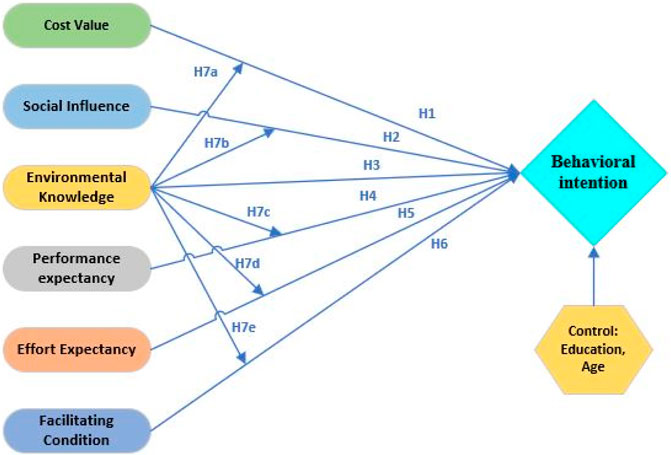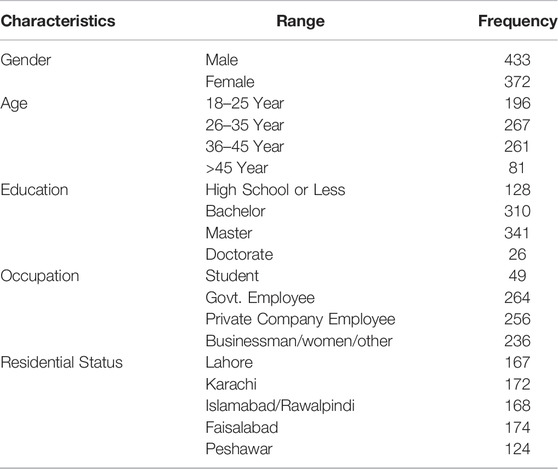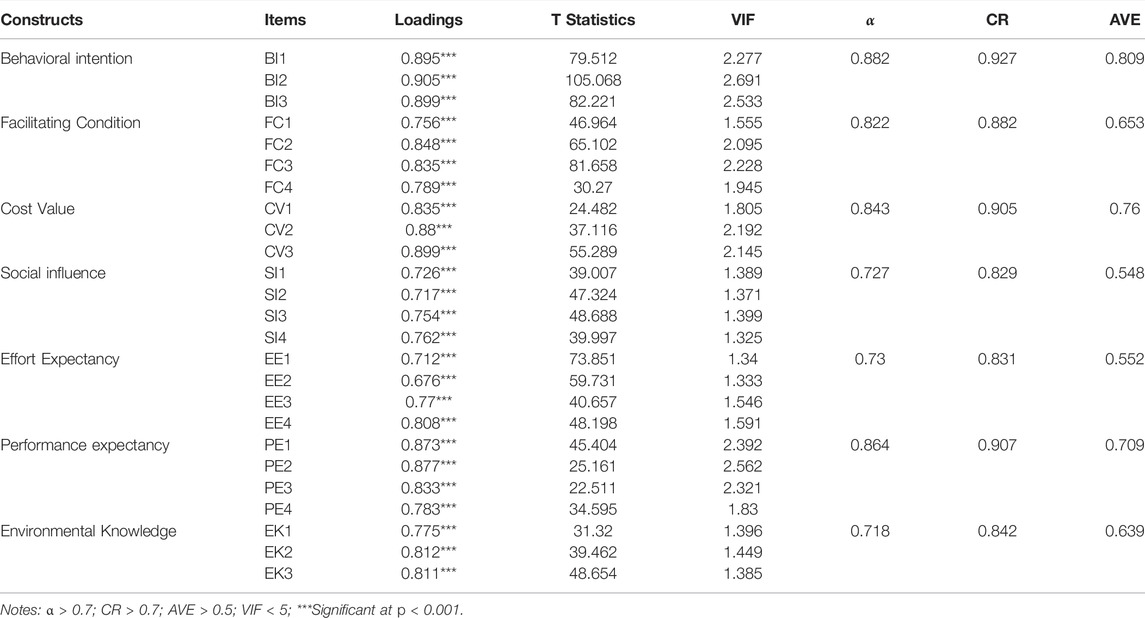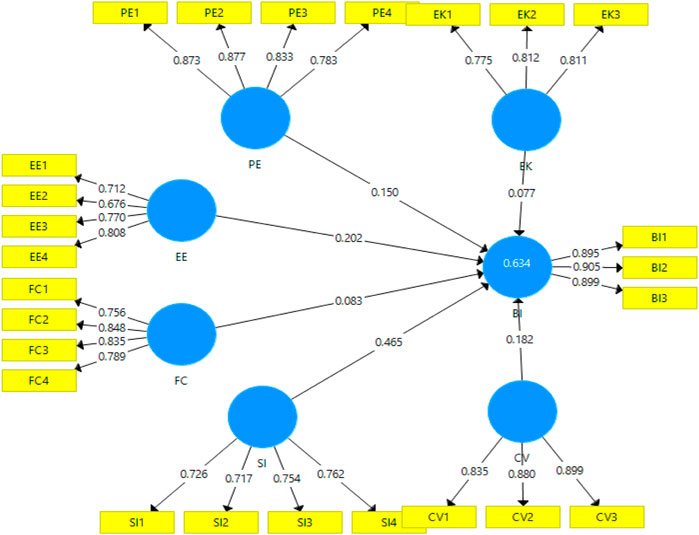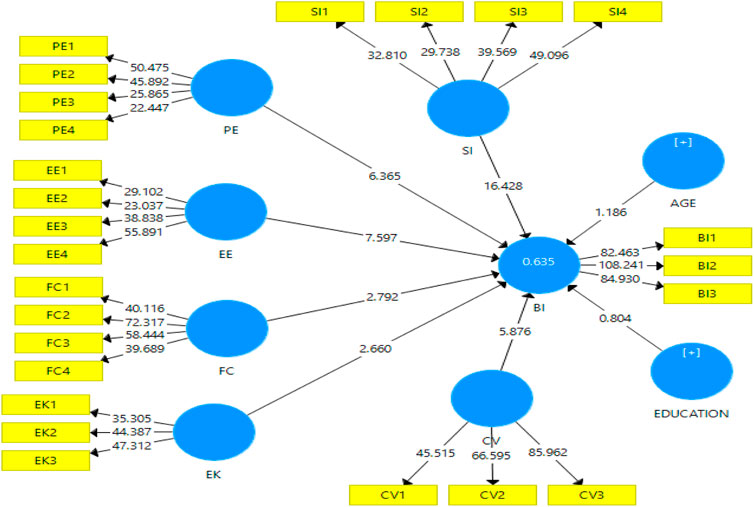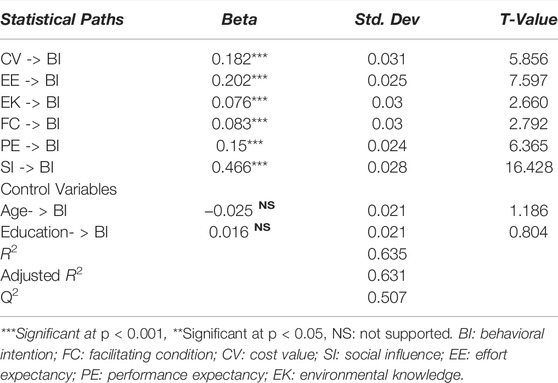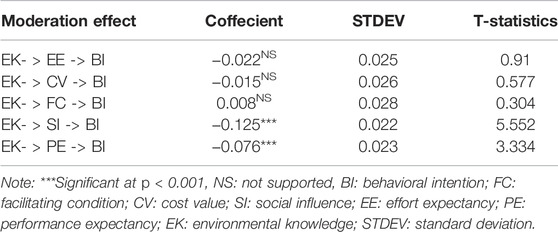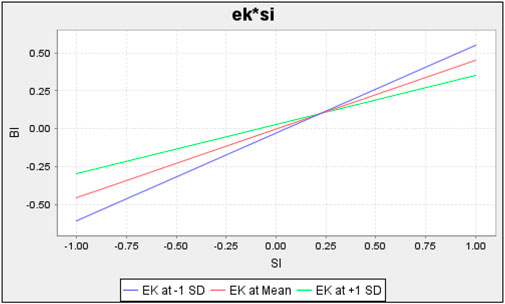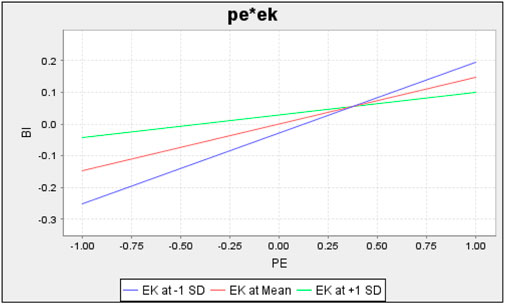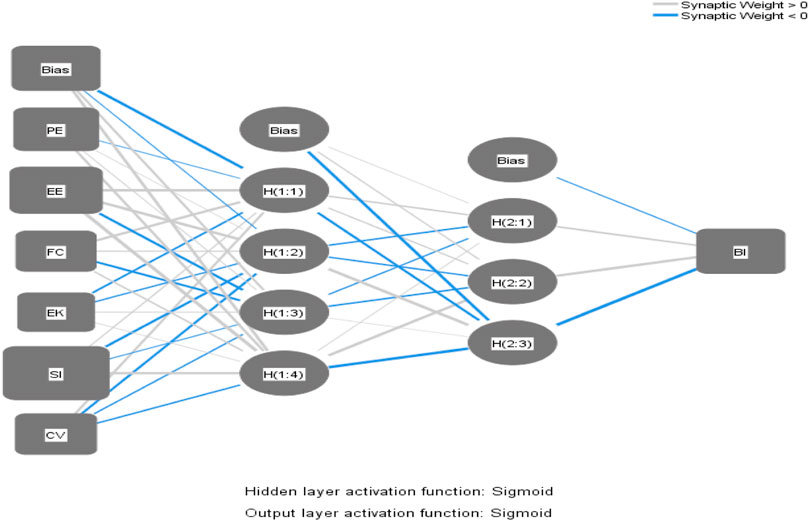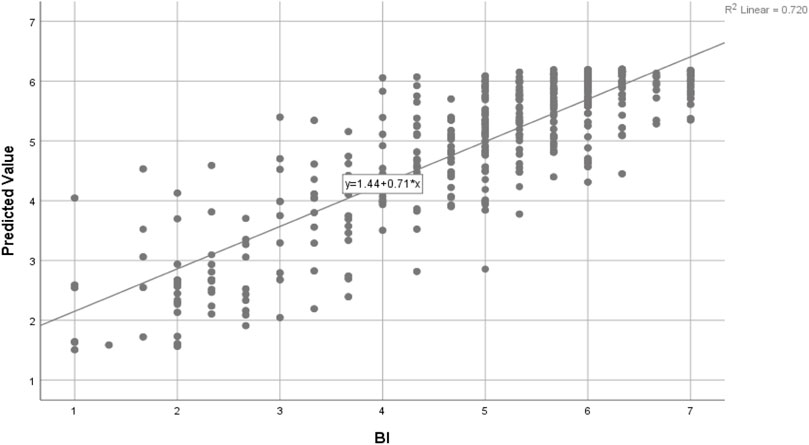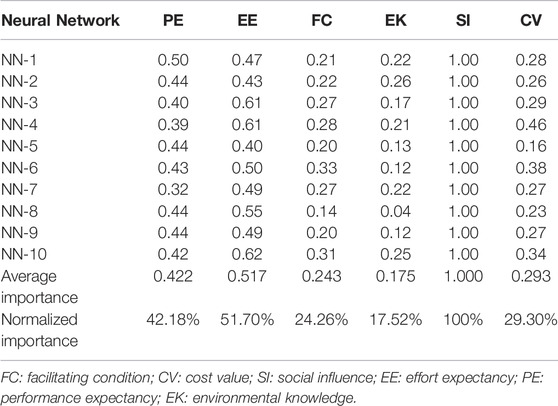- 1College of Economics and Management, Beijing University of Technology, Beijing, China
- 2Asia-Europe Institute, University of Malaya, Kuala Lumpur, Malaysia
- 3School of Economics and Management, North China Electric Power University, Beijing, China
- 4Faculty of Education, University of Malaya, Kuala Lumpur, Malaysia
- 5Department of Business Administration, National College of Business Administration and Economics, Lahore, Pakistan
Sustainable green economy is the need of time, and eco-friendly products can play a decisive role in this goal. Low consumption of eco-friendly products is a serious concern of researchers and policymakers. To address this issue, we have studied the phenomenon in a developing country and provided insights to researchers and policymakers about the factors that influence the consumers’ behaviour in developing behaviour. We have designed an integrated model based on UTAUT to study the developing countries’ behavioural intentions towards eco-friendly products. 805 useable sample is obtained to analyze by implying SEM-ANN dual-stage hybrid model. Results revealed that environmental knowledge is a significant predictor and a moderator, but consumers are less educated about ecological issues in developing countries. Results also revealed that male and female consumers’ preferences are differently influenced by factors studied to measure adoption intentions of eco-friendly products. Sensitivity analysis results revealed that social influence followed by effort expectance and perceived expectancy of eco-friendly products are more important for developing countries’ customers. The study also provides empirical evidence of methodological advancement using SEM-ANN and suggests a dual-stage hybrid model in studies involving human behaviour.
Introduction
A resource-efficient, low-carbon, and socially inclusive economy are the defining characteristics of a green economy. In a green economy, employment and income growth are driven by private and public investment into infrastructure, economic activities, and assets that allow for reduced pollution, carbon emissions, resource efficiency and increased energy, and preventative measures of the loss of ecosystem services and biodiversity. These environmentally conscious investments need to be made possible and supported by means of policy reforms, directed public spending, and changes in taxes and regulations. Since the United Nations Conference on Environment and Development (UNCED) in 1992, the primary objective of the global community has been to work toward the achievement of sustainable development.
The world’s natural resources are inextricably tied to human communities, and human societies are reliant on these natural resources. Because of the threat that climate change poses to the future of contemporary societies, planetary boundaries have been crossed, and resource stocks are getting dangerously close to depletion. As a result, societal change on all levels is required, including, but not limited to, changes in individual consumption (Steffen et al., 2018). While a significant number of Europeans are concerned about the effects of climate change (Ballew et al., 2019) and believe it is necessary to safeguard the environment, behaviour change has not followed the pace (Landry, Gifford, Milfont, Weeks, & Arnocky, 2018). As a result, it is essential to get an understanding of how individuals might be assisted in successfully altering their decisions and behaviours (Clayton et al., 2015).
Developing countries comprise the majority of the world population, and a dream of a sustainable healthy green economy and protecting the ecosystem can not be achieved until and unless the major chunk of the population does not respond responsibly.
Recent studies have studied the elements that influence the purchasing of environmentally friendly goods under the attitude-behaviour-context (ABC) theory and the moderating impact of applications of information and communication technology (ICT) innovation (Chen et al., 2021). Still, they ignore the factors such as environmental knowledge, social influence, effort expectancy, cost value and facilitating conditions. Especially the moderating role of environmental knowledge proved a significant factor and has the potential to moderate the relationship of different predictors on eco-friendly products adoption. Another study was conducted in Germany to study behavioural intention to use eco-friendly packaging (Koch, Frommeyer, & Schewe, 2022). It also ignored measuring the mentioned factors’ influence on consumers’ behaviour toward eco-friendly products. In addition, this study has been carried out in a developed country, and the behavioural influence of developing countries’ consumers is different from those of developed. Another study in Italy measured the non-green and green adult consumer purchase behaviour. Researchers measured the factors such as self-identity, environmental consequences, perceived personal inconvenience of purchasing, and moral obligations (Barbarossa & De Pelsmacker, 2016). A recent study in Vietnam measured the consumer’s concerns and ethical behaviour toward plastic products (Chi, 2022) but ignored eco-friendly products. The same is the case with Eco-friendly mask preferences in Indonesia (Hartanto & Triastianti, 2022) and consumer preference for buying cheaper versus eco-friendly cars (Armenio, Bergantino, Intini, & Morone, 2022). Apart from this, non of the studies has exclusively measured the behavioural intention of male and female consumers to provide a gender-specific solution to the low sale of eco-friendly products and encourage both segments of society to consume eco-friendly products.
Eco-friendly product manufacturing and its use can significantly affect a sustainable green economy. High CO2 emissions through different resources, such as excessive crude oil consumption (Mustafa, Zhang, & Li, 2021) and plastic products or other environmentally unfriendly materials, cause damage to the ecological system (Rackow, 2020). Turning consumers’ behaviour toward the use of eco-friendly products is a challenge. If people are successfully motivated to buy and use eco-friendly products, the dream of a sustainable green economy can be achieved. To fill the above-mentioned research gap, we have proposed the dollowing research question that will help us understand the developing countries concumer behaviour towards eco-friendly products and rank the factors according to their importance.
RQ1: What factors influence the behavioural intentions of developing countries’ consumers to use eco-friendly products?
RQ2: Do behavioural intentions of developing countries’ consumers towards eco-friendly products fluctuate with gender?
RQ3: What are the most significant factors (importance-wise) for developing countries’ consumers’ behavioural intentions to use eco-friendly products?
Based on the UTAUT, we have designed an integrated model to answer the above research questions and collected data from developing country consumers. We have used SEM-ANN two-step hybrid model to capture linear and non-linear interaction between variables and rank the factors according to their normalized importance. Results revealed that Environmental knowledge, cost, social influence, effort expectancy, perceived performance, and facilitating conditions affect consumers’ behavioural intentions toward eco-friendly products. But these factors are not equally influenced when we compare both genders—environmental knowledge moderates the relationship between social influence, performance expectancy and behavioural intention. Lastly, sensitivity analysis revealed that social influence is the most important factor for consumers in developing countries, followed by effort expectancy and performance expectancy.
Theoretical Background
Unified Theory of Acceptance and Use of Technology
UTAUT was presented in 2003 to understand the consumers’ behaviour towards adopting innovations and new technologies (Venkatesh, Morris, Davis, & Davis, 2003). The acronym UTAUT stands for the social, economic, and psychological elements that influence customers’ choices about acquiring and using a new product. In order to have a better understanding of how consumers purchase eco-friendly products in developing countries, we have selected these characteristics from UTAUT. In the past, researchers have used this theory in various contexts, such as buying smartwatches (Mustafa et al., 2022a) 5G technology (Mustafa et al., 2022b) etc. Based on UTAUT, we have developed a model and integrated environmental knowledge to study the developing countries’ users’ behavioural intentions towards eco-friendly products. A conceptual framework is presented in Figure 1.
Literature Review and Hypothesis Development
Cost Value
When it comes to making purchasing choices, consumers are often swayed by a variety of economic considerations. It is a well-known fact that consumers’ decisions to buy or pass on things are heavily influenced by their current levels of wealth (Mustafa et al., 2022c; Mustafa et al., 2022d).
Recent studies have shown that the price of a product has a significant impact on the likelihood that a customer will purchase a new product (Mustafa et al., 2022a). According to (Venkatesh et al., 2003), the term “cost value” refers to the perceived benefit of a product less the associated expenses of purchasing those goods. According to (Mustafa et al., 2021), one component of cost value is “the lowest feasible expenditures and the highest potential return on investment.” Similarly, according to the fair choice theorem, pricing value will always find a way to strike a balance between a company’s operating expenses and the profits it generates (Boudon, 2008). On the other hand, researchers have also revealed that price value is not a significant predictor of mHealth adoption (Alam, Alam, Rahman, & Taghizadeh, 2021). With this literature, we concluded that the cost of eco-friendly products would affect the adoption behavior of consumers in developing countries; hence we hypothesize that
H1: The cost of eco-friendly products will influence the consumers’ behavioural intentions in developing countries.
Social Influence
Several theories of technology acquisition consider social factors to be important drivers of technology adoption. Social influence is consistently ranked as the most significant social component in models of how people embrace new technologies (Mustafa et al., 2022e). According to (Venkatesh et al., 2003), one definition of “social influence” is when an individual considers the views of others to be significant enough to purchase the product as a result of that influence. It is common practice to refer to other people’s effect on a person’s decision-making processes as “social influence” (Mustafa et al., 2022b; Mustafa et al., 2022c). Consumers’ purchasing decisions are heavily influenced by personal perspectives and their effects on society. According to the findings of research that investigated how customers make use of services connected to technology, social influence has a substantial effect on consumers’ purchasing and use patterns (Mustafa et al., 2022d). With this literature, we hypothesize that
H2: Social influence will influence the developing countries’ consumers’ behavioural intentions toward eco-friendly products.
Environmental Knowledge
To have knowledge of the environment requires not just awareness of environmental problems and their effects but also acknowledgement and a sense of communal responsibility (Mustafa et al., 2022a). People who have more information about a topic and can respond to it in a more constructive manner are more engaged than those who have less information. Environmental intelligence may modify consumers’ perceptions of their surroundings, which can change consumers’ intentions towards their conduct. Additionally, it has been shown in a number of different pieces of study that consumers’ environmental awareness and preferences impact their purchasing choices (Sohail et al., 2022a; Mustafa et al., 2022b). Researchers have also found that environmental knowledge positively influences environmental risk perception, environmental concerns, and sustainable consumption (Saari, Damberg, Frömbling, & Ringle, 2021). With this literature, we have a hypothesis that
H3: Environmental knowledge positively influences developing countries’ consumers’ behavioral intention toward the use of eco-friendly products.
Performance Expectancy
The term “performance expectation” refers to the value customers anticipate receiving from a product or service, such as mobile internet technology, while they go about their everyday lives (Venkatesh et al., 2003). The way performance is perceived might serve as a reliable indication of future motivation to use new technologies or items. Research on mobile apps often makes use of the concept of performance expectation to understand behavioural and functional intents. (Mustafa et al., 2022c). conducted a research in which they came to the conclusion that the perceived performance of mobile phone services was a major predictor of future happiness and usage. According to researchers’ findings (Mustafa et al., 2021), performance expectations are a crucial driving force behind the adoption of electronic vehicles. The expected level of performance is a crucial variable in the use of smartwatches (Mustafa et al., 2022d). With this, we believe that the performance expectancy of eco-friendly products will influence consumers to adopt and use them in the future in developing countries, which will help achieve a sustainable green economy. With this, we hypothesis.
H4: Performance expectancy of eco-friendly products will influence consumers’ behavioural intention in developing countries.
Effort Expectancy
The term “effort expectation” (EE) refers to how straightforward a system or new product is to operate (Venkatesh et al., 2003). According to researchers’ findings, EE is an essential component in the purchase of any technological product. This is due to the fact that customers are more likely to purchase an easy-to-use product as opposed to one that is difficult to master (Mustafa et al., 2021; Mustafa et al., 2022a).
According to (Mustafa et al., 2022b), people are more responsive to new technology when it can be obtained easily and used in a straightforward manner. The same results that were disclosed in the purchase decision of electric cars were published, and they demonstrated that consumers desire to buy them provided they are simple to use and run (Mustafa et al., 2021). Conclusively, consumers have different perceptions towards new products, especially those with advanced features to help recover the environment. Less-educated consumers often consider them hard to use and initially hesitate in their adoption (Mustafa et al., 2021). We believe that EE will influence consumers in their decision to buy and use eco-friendly products. Hence we hypothesize that
H5: Effort expectance of eco-friendly products will influence developing countries’ consumers’ behavioural intentions toward eco-friendly product use.
Facilitating Conditions (SI)
The phrase “facilitating conditions” (FC) is a word that is used to refer to the instruments and resources that are employed to make use of technological advancement or new products (Venkatesh et al., 2003; Mustafa et al., 2022c). According to the findings of a number of researchers, facilitating conditions are positively associated with the purchasing decision of consumers for technically advanced and innovative products such as mobile internet (Mustafa et al., 2022d), solar panels (Ahmar, Ali, Jiang, Wang, & Iqbal, 2022), purchase of electronic vehicles (Mustafa et al., 2021), and so on. As was the case in this research, eco-friendly products are normally equipped with advanced technology that serves as a medium to save the environment or is made up of reusable organic material. Hence we believe that facilitating conditions and associated knowledge will influence consumers’ behavioural intentions towards eco-friendly knowledge; based on this, we hypothesize,
H6: Facilitating conditions for eco-friendly products will influence developing countries’ consumers’ behavioural intentions toward using eco-friendly products.
Gender Difference in Consumers’ Psyche
Researchers found that males had an emotional connection to the styles they experienced in their infancy, although women do not; this means that their preferences for trendy items reached their pinnacle when they were younger (Schindler & Holbrook, 2003). In a different piece of research, the researchers found that women are more likely than males to change their future purchase behaviours as a result of receiving promotional presents. Consequently, women are more likely to be motivated to reciprocate since they gain a greater value from the transactional aspect of a promotional purchase than males (Kovacheva, Nikolova, & Lamberton, 2021). A recent study found that consumers of the male gender tend to place a higher priority on quality, in contrast to females, who are more likely to be affected by social factors while making purchases. Compared to their male counterparts, females have a greater awareness of prices (Mustafa et al., 2022a). According to the findings of this body of research, gender does have a role in customers’ decision-making process. Based on this, we have decided to analyze the gender-specific paths in our study so that a clear picture can be presented.
Moderation Effect of Environment Knowledge
Environmental knowledge is a factor that can make a difference in the consumer’s choice of eco-friendly products and can help achieve a sustainable green economy. A broad understanding of facts, ideas, and connections relating to the natural environment and its primary ecosystem is what is meant when someone says they have “environmental knowledge.” Researchers have recently discovered that environmental knowledge strengthens the relationship between green human resource management and pro-environmental behaviors (Sohail et al., 2022b; Farrukh, Ansari, Raza, Wu, & Wang, 2022). Researchers believe that people who have a better awareness and knowledge of environmental-related issues are more likely to pick eco-friendly products and technologies (Mustafa et al., 2022b) same is found in the case of electronic vehicles (Mustafa et al., 2021). Another study on the green apparel buying behaviour revealed that environmental knowledge moderates the relationship between consumer pessimism, optimism, environmental orientation and Green apparel buying behavior (Sadiq, Bharti, Adil, & Singh, 2021). Therefore, people who have a strong understanding of environmental issues are more inclined to choose green items, which have a less detrimental effect on the environment. Individuals have a wide range of environmental awareness and comprehension; hence, it is essential to explore the border condition established by the amount of knowledge between the PE, CV, EE FC, SI and the BI. With this discussion we proposed the following,
H7: Environmental knowledge will moderate the relationship between cost value (a), social influence (b), performance expectancy (c), effort expectancy (d), facilitating conditions (e), and Behavioural intention to use eco-friendly products in developing countries.
Methodology
Research Context
Developing countries are struggling to play their role in achieving the UN Environment-led Green Economy goal. As classified by the International monetary fund, developing counties contain 85% of the world population (Worlddata, 2021). To test our proposed model, we have selected Pakistan, one of the developing countries that took the initiative to plant a billion trees to achieve a sustainable green economy. A country with 220 million people committed to playing their role towards a green economy and sustainable environment-friendly atmosphere. Around 60% of the population in the country is below the age of 50 and has the potential to play its role in achieving the sustainable goal of a green economy. The billion tree initiative, population share in the world as the 5th populous country and population age segregation are some of the reasons to select Pakistan to study the intentions of individuals towards buying eco-friendly products for the sustainable growth of the green economy.
Questionnaire Design and Data Collection
We made use of a tool that has been shown to be effective in the past. Each measuring item’s setup and properties are described in detail in the accompanying material. We don’t do much tinkering with the original concepts for our study structures to improve their performance. There were three academics who are experts in the subject who helped us with the instrument’s design. A pilot study was then done to see how long respondents spent filling out a questionnaire and what they had to say. A group of thirty graduate students (both master’s and bachelor’s) was chosen for a pilot study. During the pilot project, we spoke with academic experts to further understand consumers’ behavior and incorporate their suggestions. Although the pilot project’s findings were positive, the pilot participants were not included in the final sample.
We opted to conduct the poll online because of the possibility of human error and manual data entry. Our target audience’s cross-sectional dataset/response has been collected using a seven-point Likert scale. With a “strongly disagree” rating of 1 and a “strongly agree” rating of 7 (Supplementary Table S1). Because of its precision and ease of administration, the 7-point Likert scale is preferred by scientists over higher-order alternative measures (Finstad, 2010). We’ve split the population into five areas based on factors like literacy, population density, and other infrastructure (Karachi, Islamabad/Rawalpindi, Lahore, Faisalabad, Peshawar). A systematic sampling approach was used to choose every twentieth customer who went to the supermarkets in these clusters. The administration of the survey and the gathering of replies were carried out with the assistance of Google forms. It was required that respondents submit their mobile phone numbers to prevent making duplicate attempts, for the sake of data cleansing, and to gather follow-up replies. The poll was conducted over the course of 2 weeks, from the second to the third week of February 2022. Eleven hundred questionnaires were distributed among five clusters, with each cluster receiving a total of 220 survey questionnaires. We received a total of 805 valid replies, which corresponds to a response rate of 73.18 percent overall. In order to carry out statistical analysis, the sample size is much more than the minimum need of 10 times for each construct component (Hair, Howard, & Nitzl, 2020).
Demographics of Respondents
We have compiled the respondent’s age, education level, gender, residence status, employment, and other relevant information to have a more comprehensive understanding of our research sample and its features. Table 1 has a detailed presentation of the demographic information on our whole sample size (805).
Common Method Bias
A common method bias (CMB) is possible if the same response approach is used to assess both the explained and exploratory variables. Common methodological bias has the potential to undermine the validity of an investigation. Previous academics have suggested a number of operational and statistical safeguards to protect against the CMB (Podsakoff, MacKenzie, & Podsakoff, 2012; Mustafa & Wen, 2022). We have explained the goal of the research as well as how the collected data will be used for all of the participants. Before responding to the questionnaire, every respondent was provided with a comprehensive explanation. During the process of preparing the questionnaire, we also considered linguistic and academic specialists, which allows us to make the questions straightforward for the respondents to comprehend. Before providing the respondents with a questionnaire, we first clarified to them that there are no hard and fast rules to follow when selecting the appropriate response. It is necessary for respondents to offer their responses and perspectives. We made it quite clear that there would be no consideration of right or wrong. We carried out the suggested Harman’s single-factor analysis in the analysis section. The findings indicated that the single factor accounts for just 31.858 percent of the total variance, which is a significant amount lower than the recommended threshold value of 50 percent (Podsakoff et al., 2012; Zhongjun, Shah, Ahmad, & Mustafa, 2022). As a result, the CMB does not pose a significant risk in our investigation.
PLS-SEM
We picked PLS-SEM because it is the most often recommended technique for circumstances in which the research is focused on predicting and assessing dependent variables to account for the maximum amount of variance. The PLS-SEM approach is the most effective prediction-oriented strategy (Roldán & Sánchez-Franco, 2012). In addition, it is capable of processing both the measurement and structural models (inside and out) at the same time. Aside from that, it is capable of analyzing complex path models (Hair Jr, Hult, Ringle, & Sarstedt, 2016). A smaller sample size may be used with PLS-SEM while still obtaining higher-quality results.
Recently researchers revealed that the growth of the PLS-SEM technique might be explained by its prospective benefits in management science (Awan et al., 2021; Mustafa et al., 2022a; Mustafa et al., 2022c; Mustafa et al., 2022d). Consequently, it seems that PLS-SEM is the best approach for this study. Two stages of the PLS path modelling approach are evaluated to ensure that the measurements of the constructs are correct and reliable. The first stage evaluates measurement model reliability and validity; the second stage evaluates structural model validity to define an inner model or link between latent constructs (Hair et al., 2016; Hair et al., 2020). However, since the model considers non-linear interactions, it is advantageous to carry out an analysis divided into two phases.
Multivariate Assumptions
Before doing a multivariate analysis, researchers assert that certain multivariate assumptions must first be validated. These assumptions include linearity, homoscedasticity, and multicollinearity (Gul et al., 2021; Jamil et al., 2021; Jamil et al., 2022a). Data were tested to see whether it followed a normal distribution using the Kolmogorov-Smirnov (K-S) test; however, the results suggest that the data do not (Hew, Leong, Tan, Ooi, & Lee, 2019). Supplementary Figure S1 demonstrates both linear and non-linear interactions between explained and exploratory variables. Finally, the variance inflation factor (VIF) scores were assessed to see whether the model had collinearity problems. This study shows that the VIF values for all variables are less than 5 (Table 2). (Hair et al., 2016) state that VIF values less than 5 imply no collinearity issues with the dataset. The additional material contains indicator loadings and cross-loadings.
Measurement Model
Measurement models should be evaluated using indicators and constructs’ convergent and discriminant validity (Hair et al., 2016). Using Cronbach’s Alpha (α) and indicator loading, we were able to determine the reliability of the instrument. Testing of the indicators of the constructs was conducted to see whether or not they provide an appropriate evaluation of the study variables. The average variance extracted (AVE) and composite reliability (CR) is used to express how much variance in indicators was compensated for by the latent construct, respectively. The factor loadings on the corresponding structures are used for each item to assess the reliability (Table 2; Figure 2) (Supplementary Table S2). The item reliability is shown in Table 2. A component’s factor loading must be greater than or equal to 0.6 in order to be considered significant and included in the model (Hair et al., 2016). For further assurance, Cronbach’s Alpha for all constructions is more than or extremely close to the acceptable cutoff of 0.7 is recommended, so is in our dataset (Werts, Linn, & Jöreskog, 1974).
It was also determined if the constructs’ composite reliability (CR) was enough for gauging the constructs’ reliability instead of only using Cronbach’s alpha alone (Werts et al., 1974). Because the composite reliability values of constructs are all more than 0.7, this further enhances their validity. As can be seen from Table 2, the average variance extracted (AVE) convergent validity estimations were all more than or equal to 0.50 (Hair et al., 2016; Hair et al., 2020; Jamil et al., 2022b). These results ensure that the dataset is adequate to perform further analysis.
In addition, the Fornell-Larcker criteria and heterotrait-monotrait (HTMT) ratios are incorporated to assess the proposed model’s discriminant validity (Hair et al., 2020). Fornell-Larcker criteria show that discriminant validity is validated, as seen in Table 3, where the highest value of the association of measures is maximal in each column (Fornell & Larcker, 1981). The technique (HTMT ratio) suggested by (Henseler, Ringle, & Sarstedt, 2015) is a new approach to assessing discriminant validity. They contended that the Fornell-Larcker criteria could not distinguish between the presence and lack of discriminant validity despite its efficiency in assessing discriminant validity. As a consequence of this, the HTMT was used to establish the discriminant validity. Table 4 displays the HTMT values for the factors considered throughout this research. In order to satisfy the requirements, the HTMT values of all the variables must be lower than 0.90. (Henseler et al., 2015). As can be seen in Table 4, the HTMT values for all measures fall below the threshold of 0.90, which indicates that the discriminant validity of the variables is established.
Structural Model Assessment
The PLS-SEM evaluation method is broken down into many steps, the second of which is the examination of the structural model. In order to evaluate the structural path model, it is necessary to evaluate the multicollinearity of the data, as well as the predictive relevance of the model, the empirical significance of the path coefficients, and the level of confidence. In addition, it is necessary to evaluate the degree to which the structural path model can be trusted. In this study, guidelines explained by (Hair et al., 2016) were employed with the aim of assessing the structural model and interpreting the results.
We have run a model to analyze the direct effects of factors on BI. Hence the PLS-SEM path analysis results (Figure 3) revealed that R2 = 0.634 (Q2 = 0.507). Our model explains 63.4 percent of the variation in BI is driven by the independent factors (Table 5). Q2 is used to determine whether or not a model has predictive relevance and serves as a measurement for predictive relevance. According to the values of Q2 generated by our model, the predictive importance of the endogenous components has been demonstrated.
In order to analyze the previously stated hypothesis, we first looked at the direct relationships between the different variables, and then we used a bootstrapping test with 5,000 repetitions to see how well the results compared to the original hypothesis (Mustafa et al., 2021; Mustafa et al., 2022b). PLS-SEM direct path analysis revealed that CV (β = −0.182; p < 0.001), EE (β = 0.202; p < 0.001), EK (β = 0.076; p < 0.001), FC (β = 0.083; p < 0.001), PE (β = 0.15; p < 0.001), and SI (β = 0.466; p < 0.001) for BI has statistically significant values of beta (β) (Table 5). These results confirm the proposed H1 to H6. We have also tested the control variables’ education level and age, but these have no significant effect on consumers’ behavior.
In addition, we used PLS-MGA in order to access the group-specific effects for both genders, and we provided the bootstrapped results separately for men and females. In order to guarantee that this model has the same architecture as model 1 (Table 5), we have utilized the bootstrapping technique with 5,000 resamplings.
Although the proposed hypothesis significantly influences model 1 for the overall sample, we have found some unique results in PLS-MGA. Results revealed that EK (β = 0.052; p = 0.2) has no influence on BI for the Female sample, and FC (β = 0.068; p = 0.113) has no influence for the male sample. At the same time, the rest of the hypothesis held for both genders (Table 6).
Moderation Analysis
(Hair et al., 2016) proposed the product indicator approach, which we used to illustrate the moderating effect of environmental knowledge on the direct link between CV, FC, PE, EE, and SI on BI using the product indicator method. We hoped that higher knowledge of the environment would strengthen the BI of consumers’ to choose environmentally friendly items and the other way around. Moderation analysis results are presented in Table 7. Results revealed that Environmental knowledge only moderate two relationships in our study, i.e., EK- > SI- > BI (β = -0.125, t = 5.552, p < 0.001) and EK- > PE- > BI (β = -0.076, t = 3.334, p < 0.001). It confirms the proposed hypotheses H7b and H7c, whereas the results reject the H7a,d,e. Higher knowledge of environmental issues will weaken the strength of social influence and performance expectancy on BI. Figure 4 and Figure 5 present the slope plot for environmental knowledge’s moderation effect on SI, PE relation with BI.
Results revealed weak significant moderation, and surprisingly higher environmental knowledge negatively moderates the relationship, as mentioned in Table 7. So in the case of developing countries higher amount of environmental knowledge is weakening their intentions to use eco-friendly products.
Artificial Neural Network
An artificial neural network, also known as an ANN, is a tool for non-linear statistical data simulation that may be trained several times to improve the performance of the model (Mustafa et al., 2021). The prediction of outcomes and the classification of data are two applications of ANN. The ANN model performs better than other multivariate models when it comes to prediction; nevertheless, the inclusion of “BLACBOX” is not appropriate for testing hypotheses (Hew et al., 2019; Mustafa et al., 2021; Mustafa et al., 2022c). ANN does not require any multivariate assumptions and works perfectly with a low dataset. Hence, researchers believe it can be integrated with SEM to obtain better and more consistent results (Alam et al., 2021; Mustafa et al., 2021). This is especially true if the multivariate assumptions are violated or the sample size is small, as ANN does not require any multivariate assumptions. Due to the fact that the dataset contains some non-linear interaction, as stated in the supplemental material, it is more suitable for the two-stage analysis. On the other hand, in response to RQ3, in which we wish to rank the predictors as per their normalized significance, we have used ANN in the second stage of the study.
Following the lead of early researchers (Alam et al., 2021; Mustafa et al., 2021), we have built an artificial neural network (ANN) model for BI. The sigmoid was chosen as the activation function, and there are two hidden layers of neurons (Figure 6). In order to avoid the model from being over-fit to the data, a technique known as 10-fold cross-validation was used. Ninety percent of the data was utilized for training, while only ten percent was utilized for testing (Table 8).
Table 8 presents the root mean square of errors (RMSE). RMSE represents the model predictive power (Hew et al., 2019; Mustafa et al., 2021). In our model, RMSE values for training (Mean = 0.096; STD = 0.006) and testing (Mean = 0.088; STD = 0.009) represent the high predictive power of the constructed ANN model for BI.
In addition, in order to assess the efficacy of the ANN models, we developed a goodness-of-fit coefficient on the basis of a certain approach. This coefficient is comparable to the R2 value discovered in the regression models (Figure 7).
Sensitivity Analysis
An ANN model was used to conduct a sensitivity analysis, and the results of that study are shown in Table 9. The fact that the hidden layer of the ANN model had synaptic weights that were not equal to zero provided supporting evidence for the significance of the inputs. The output of the model is highly sensitive to changes in the values of the different inputs, which are then used to estimate the “relative importance” of each component. The model’s output is very sensitive to fluctuations in the value of the various inputs. With these discoveries, we were able to estimate the normalized importance of each variable by doing a ratio calculation in relation to the value that was discovered to be the greatest overall. This allowed us to decide which variables were most important.
Based on the sensitivity analysis results, we concluded that Social influence has the highest relative normalized importance for our sample (100%), followed by Effort Expectancy (51.70%) and Performance expectancy (42.18%). We have also found that cost value (29.30%) and facilitating conditions (24.26%) are the least important factors for consumers to adopt eco-friendly products in developing countries.
Discussion
This study aims to understand developing countries’ customers’ behavioural intentions towards the adoption and use of eco-friendly products that can lead to support the economic revival of developing countries and achieve the goal of a sustainable green economy. We have proposed an integrated model based on UTAUT and analyzed the collected dataset by applying the SEM-ANN hybrid two-stage approach.
Three research questions are presented to study the said role of eco-friendly products in developing countries. H1-H6 answers the RQ1, results presented in Table 6 answer RQ2, and sensitivity analysis results presented in Table 9 answer RQ3.
People from developing countries are concerned about the ecosystem and want to play their role in a sustainable green economy. Cost value plays a significant positive role in the adoption intentions of developing countries and supports H1. It means the consumer in developing countries are willing to pay an extra price if they compare the value and cost (health, money, environmental damage). It is consistent with the earlier results (Koch et al., 2022) but contradicts (Alam et al., 2021). H2, developing countries’ consumers are highly influenced by the social norms and give value to others’ opinions when it comes to using new products. The results indicate if someone from a close circle of friends or society is advising individuals, they listen to the opinion and are inclined toward the eco-friendly products. It is consistent with recent findings (Mustafa et al., 2022a; Mustafa et al., 2022b).
Environmental knowledge that has received less attention in the context of eco-friendly products in recent studies was found to be positively associated with behavioural intentions (H3), which means people from developing countries have some knowledge and as much as an individual has an environmental knowledge, as much as he/she is inclined to adopt eco-friendly products in routine life. The findings are close to the recent findings for 5 g adoption (Mustafa et al., 2022c). H4, performance expectancy of eco-friendly products is also a positive influence on behavioural intention, which means consumers perceive that their daily routine performance will boost if they use eco-friendly products. They will play their part as an individual toward a green economy by using eco-friendly products.
Effort expectancy positively influences behavioural intentions (H5), which means if the eco-friendly products are easy to use and simple in their structure to recycle, consumers will use them. It can play a significant role in a step towards a sustainable green economy. H6, facilitating conditions also play a positive role in adopting eco-friendly products, which means if a healthy infrastructure is introduced to people that support eco-friendly products, people will incline toward eco-friendly products.
In response to RQ2, PLS-MGA results revealed two surprising facts. 1) Environmental knowledge does not play any role in female consumers’ adoption of eco-friendly products, and they do not care about environmental issues. It can be because they have less knowledge about ecological issues. 2) Male consumers in developing countries do not influence by social influence, which is possible because males have to discuss less about ecological issues in their social circle or because they are self-initiative and value their own opinion rather than listening to others or the following society. They deviate from herd behaviour in eco-friendly product adoption. We can conclude that developing countries’ consumers’ decision psyche is different for different gender. It is consistent with a recently published study (Mustafa et al., 2022d).
Furthermore, to answer H7, we have run a moderation analysis, and the results revealed a small significant moderation of environmental knowledge. Surprisingly environmental knowledge negatively moderates the relationship between social influence, performance expectancy and BI to eco-friendly products. The possible reason for this negative moderation in developing countries is if an individual already has enough knowledge about environmental issues and ecological problems and knows its role as an individual entity in saving the ecological system and achieving a sustainable green economy, he might not value the social advise or perceived expectancy of eco-friendly products and keep doing whatever is in favour of collective good.
In response to RQ3, sensitivity analysis results were performed by constructing an ANN model for BI, and results revealed that developing countries’ consumers value social influence a lot, and it is followed by the Effort expectancy (second most important factor) and perceived expectancy (third most important). It means if eco-friendly products need to be promoted in developing countries and achieve a sustainable green economy in developing countries, policymakers and eco-friendly product producers must emphasise these factors.
Theoretical Contribution
The study contributes to the available literature substantially. It provides further explanations for studies conducted in developed countries (Barbarossa & De Pelsmacker, 2016; Armenio et al., 2022; Koch et al., 2022) and developing countries (Chi, 2022; Hartanto & Triastianti, 2022). We have tried to fill the research gap by illuminating the influential factors behind eco-friendly product use in developing countries. Firstly we have provided insight into the developing countries’ consumers and their behaviour towards the use of eco-friendly products. Secondly, we have provided evidence that gender factors influence the consumers’ preferences in developing countries, and both genders think about environment-related issues differently. Thirdly we have added in the existing literature that environmental knowledge is a factor that can play an important role in developing countries’ green economy goals. It is an influential factor and a potential mediator in the adoption of eco-friendly products. Lastly, we have provided the normalised importance of every influential factor behind adopting eco-friendly products in developing countries.
Furthermore, we have used a dual-stage SEM-ANN analysis, and the variance explained in the second stage (72%) results is considerably higher than SEM results (63%). It is a considerable methodological advancement. We recommend using the dual-stage SEM-ANN model in studies where the human psyche is involved or prediction of the outcome is required as ANN is more consistent in prediction.
Policy Implications
Based on the study’s findings, we have some recommendations for policymakers and economic advisors. Eco-friendly products can help revive developing countries’ economies and support achieving the goal of a sustainable green economy. People from developing countries have less knowledge about environmental-related issues. We suggest the governments of developing countries and other stakeholders in the global green economy goal and those working on the ecological system emphasise educating developing countries’ populations, especially the female section of the population. When people are aware of the consequences of not using eco-friendly products and their benefits, they will turn their priorities toward eco-friendly products. The public campaign in favour of eco-friendly and resource-efficient products can play a vital role in achieving the goal of a green economy. A better environmental friendly infrastructure needs to design and promoted in developing countries.
Furthermore, eco-friendly products are reusable/recyclable and can save world resources, especially in developing countries. It can support reviving the shattered and dwindling economies. Helpful in saving energy resources and in saving the ecological system. Educating people about resource-efficient and eco-friendly products and advertising the benefits of eco-friendly products can pave the path to a sustainable green economy.
Limitations and Future Work Directions
The study implies some limitations that can lead to future avenues for further research. Firstly, we have collected our sample from a single country, which can limit the generalizability of the study findings. Researchers are encouraged to conduct a cross-country analysis to validate the results further. Researchers can cross-compare developed countries and developing countries or within developing countries by differentiating the geographic boundaries, e.g., Asian and African countries. Secondly, we did not measure the income level in our sample. Income level can play a role in the process, and consumers’ priorities can fluctuate with income level. We suggest adding the effect of income level in future studies. Thirdly, we study the education level as a control variable; Future researchers can study the deep impact of education level, cross-compare the educated and illiterate community members, and provide policy recommendations to educate people about environmental issues and motivate them to use resource-efficient and eco-friendly products.
Data Availability Statement
The datasets presented in this study can be found in online repositories. The names of the repository/repositories and accession number(s) can be found below: https://drive.google.com/file/d/1O67WzYxWFgFM1hUTdLrE8t-W9XimfTU7/view?usp=sharing.
Ethics Statement
Ethics review and approval/written informed consent was not required as per local legislation and institutional requirements.
Author Contributions
SM: Conceptualization, Methodology, Software, Writing—Original Draft. HT and YQ: Review the final draft, edit, visualization, and handle the data flow. KJ and MN: Investigation, and data collection and management.
Conflict of Interest
The authors declare that the research was conducted in the absence of any commercial or financial relationships that could be construed as a potential conflict of interest.
Publisher’s Note
All claims expressed in this article are solely those of the authors and do not necessarily represent those of their affiliated organizations, or those of the publisher, the editors and the reviewers. Any product that may be evaluated in this article, or claim that may be made by its manufacturer, is not guaranteed or endorsed by the publisher.
Supplementary Material
The Supplementary Material for this article can be found online at: https://www.frontiersin.org/articles/10.3389/fenvs.2022.955245/full#supplementary-material
References
Ahmar, M., Ali, F., Jiang, Y., Wang, Y., and Iqbal, K. (2022). Determinants of Adoption and the Type of Solar PV Technology Adopted in Rural Pakistan. Front. Environ. Sci. 10, 895622. doi:10.3389/fenvs.2022.895622
Alam, M. M. D., Alam, M. Z., Rahman, S. A., and Taghizadeh, S. K. (2021). Factors Influencing mHealth Adoption and its Impact on Mental Well-Being during COVID-19 Pandemic: A SEM-ANN Approach. J. Biomed. Inf. 116, 103722. doi:10.1016/j.jbi.2021.103722
Armenio, S., Bergantino, A. S., Intini, M., and Morone, A. (2022). Cheaper or Eco-Friendly Cars: What Do Consumers Prefer? An Experimental Study on Individual and Social Preferences. Ecol. Econ. 193, 107323. doi:10.1016/j.ecolecon.2021.107323
Awan, F. H., Dunnan, L., Jamil, K., Mustafa, S., Atif, M., Gul, R. F., et al. (2021). Mediating Role of Green Supply Chain Management Between Lean Manufacturing Practices and Sustainable Performance. Front. Psychol. 12, 810504. doi:10.3389/fpsyg.2021.81050410.3389/fpsyg.2021.810504
Barbarossa, C., and De Pelsmacker, P. (2016). Positive and Negative Antecedents of Purchasing Eco-Friendly Products: A Comparison between Green and Non-green Consumers. J. Bus. Ethics 134 (2), 229–247. doi:10.1007/s10551-014-2425-z
Boudon, R. (2008). “Rational Choice Theory,” in The New Blackwell Companion to Social Theory (Hoboken New Jersery, US: Wiley Online Libary), 179–195.
Chen, S., Qiu, H., Xiao, H., He, W., Mou, J., and Siponen, M. (2021). Consumption Behavior of Eco-Friendly Products and Applications of ICT Innovation. J. Clean. Prod. 287, 125436. doi:10.1016/j.jclepro.2020.125436
Chi, N. T. K. (2022). Ethical Consumption Behavior towards Eco-Friendly Plastic Products: Implication for Cleaner Production. Clean. Responsible Consum. 5, 100055. doi:10.1016/j.clrc.2022.100055
Clayton, S., Devine-Wright, P., Stern, P. C., Whitmarsh, L., Carrico, A., Steg, L., et al. (2015). Psychological Research and Global Climate Change. Nat. Clim. Change 5 (7), 640–646. doi:10.1038/nclimate2622
Farrukh, M., Ansari, N., Raza, A., Wu, Y., and Wang, H. (2022). Fostering Employee's Pro-environmental Behavior through Green Transformational Leadership, Green Human Resource Management and Environmental Knowledge. Technol. Forecast. Soc. Change 179, 121643. doi:10.1016/j.techfore.2022.121643
Finstad, K. (2010). Response Interpolation and Scale Sensitivity: Evidence Against 5-Point Scales. J. Usability Stud. 5 (3), 104–110.
Fornell, C., and Larcker, D. F. (1981). Evaluating Structural Equation Models with Unobservable Variables and Measurement Error. J. Mark. Res. 18 (1), 39–50. doi:10.1177/002224378101800104
Gul, R. F., Dunnan, L., Jamil, K., Awan, F. H., Ali, B., Qaiser, A., et al. (2021). Abusive Supervision and its Impact on Knowledge Hiding Behavior Among Sales Force. Front. Psychol. 12, 800778. doi:10.3389/fpsyg.2021.800778
Hair, J. F., Howard, M. C., and Nitzl, C. (2020). Assessing Measurement Model Quality in PLS-SEM Using Confirmatory Composite Analysis. J. Bus. Res. 109, 101–110. doi:10.1016/j.jbusres.2019.11.069
Hair, J. F., Hult, G. T. M., Ringle, C., and Sarstedt, M. (2016). A Primer on Partial Least Squares Structural Equation Modeling (PLS-SEM). California, UN: Sage publications.
Hartanto, B. W., and Triastianti, R. D. (2022). Eco-friendly Masks Preferences during COVID-19 Pandemic in Indonesia. Clean. Responsible Consum. 4, 100044. doi:10.1016/j.clrc.2021.100044
Henseler, J., Ringle, C. M., and Sarstedt, M. (2015). A New Criterion for Assessing Discriminant Validity in Variance-Based Structural Equation Modeling. J. Acad. Mark. Sci. 43 (1), 115–135. doi:10.1007/s11747-014-0403-8
Hew, J.-J., Leong, L.-Y., Tan, G. W.-H., Ooi, K.-B., and Lee, V.-H. (2019). The Age of Mobile Social Commerce: An Artificial Neural Network Analysis on its Resistances. Technol. Forecast. Soc. Change 144, 311–324. doi:10.1016/j.techfore.2017.10.007
Jamil, K., Dunnan, L., Awan, F. H., Jabeen, G., Gul, R. F., Idrees, M., et al. (2022a). Antecedents of Consumer's Purchase Intention towards Energy-Efficient Home Appliances: An Agenda of Energy Efficiency in the Post COVID-19 Era. Front. Energy Res. 10, 863127. doi:10.3389/fenrg.2022.863127
Jamil, K., Dunnan, L., Gul, R. F., Shehzad, M. U., Gillani, S. H. M., and Awan, F. H. (2022b). Role of Social Media Marketing Activities in Influencing Customer Intentions: A Perspective of a New Emerging Era. Front. Psychol. 12, 808525. doi:10.3389/fpsyg.2021.808525
Jamil, K., Liu, D., Anwar, A., Rana, M. W., Amjad, F., and Liu, M. (2021). Nexus between Relationship Marketing and Export Performance of Readymade Garments Exporting Firms. Ind. Textila 72 (6), 673–679. doi:10.35530/it.072.06.202028
Koch, J., Frommeyer, B., and Schewe, G. (2022). Managing the Transition to Eco-Friendly Packaging - An Investigation of Consumers' Motives in Online Retail. J. Clean. Prod. 351, 131504. doi:10.1016/j.jclepro.2022.131504
Kovacheva, A., Nikolova, H., and Lamberton, C. (2021). Consumers' Response to Promotional Gifts: The Role of Gender, Transactional Value, and Reciprocity. Psychol. Mark. 38 (1), 196–211. doi:10.1002/mar.21434
Landry, N., Gifford, R., Milfont, T. L., Weeks, A., and Arnocky, S. (2018). Learned Helplessness Moderates the Relationship between Environmental Concern and Behavior. J. Environ. Psychol. 55, 18–22. doi:10.1016/j.jenvp.2017.12.003
Mustafa, S., Qiao, Y., Yan, X., Anwar, A., Tengyue, H., and Rana, S. (2022a). Digital Students' Satisfaction with and Intention to Use Online Teaching Modes, Role of Big Five Personality Traits. Front. Psychol. 13, 956281. doi:10.3389/fpsyg.2022.956281
Mustafa, S., Sohail, M. T., Rubaiee, S., Anas, A., Alroobaea, R., Othman, A. M., et al. (2022d). Éclaircissement to Understand Consumers' Decision-Making Psyche and Gender Effects, a Fuzzy Set Qualitative Comparative Analysis. Front. Psychol. 13, 920594. doi:10.3389/fpsyg.2022.920594
Mustafa, S., and Wen, Z. (2022). How to Achieve Maximum Participation of Users in Technical versus Non-technical Online Q&A Communities? Int. J. Electron. Commer. 26 (4).
Mustafa, S., Wen, Z., and Naveed, M. M. (2022b). What Motivates Online Community Contributors to Contribute Consistently? A Case Study on Stackoverflow Netizens. Curr. Psychol. 41 (6). doi:10.1007/s12144-022-03307-4
Mustafa, S., Zhang, W., and Li, R. (2021). “Does Environmental Awareness Play a Role in EV Adoption? A Value-Based Adoption Model Analysis with SEM-ANN Approach,” in Paper presented at the IEEE/WIC/ACM International Conference on Web Intelligence and Intelligent Agent Technology, Melbourne VIC Australia, December 17, 2021. doi:10.1145/3498851.3498992
Mustafa, S., Zhang, W., Shehzad, M. U., Anwar, A., and Rubakula, G. (2022c). Does Health Consciousness Matter to Adopt New Technology? An Integrated Model of UTAUT2 with SEM-fsQCA Approach. Front. Psychol. 13, 836194. doi:10.3389/fpsyg.2022.836194
Mustafa, S., Tengyue, H., Qiao, Y., Sha, S. K., and Sun, R. (2022e). How a Successful Implementation and Sustainable Growth of E-Commerce can be Achieved in Developing Countries; A Pathway Towards Green Economy. Front. Environ. Sci., 10. doi:10.3389/fenvs.2022.940659
Podsakoff, P. M., MacKenzie, S. B., and Podsakoff, N. P. (2012). Sources of Method Bias in Social Science Research and Recommendations on How to Control it. Annu. Rev. Psychol. 63 (1), 539–569. doi:10.1146/annurev-psych-120710-100452
Rackow, E. (2020). Everyday Items that Are Harmful to the Environment. Available at: https://wowelifestyle.com/blogs/better-living/8-everyday-items-that-are-harmful-to-the-environment (Accessed March 16, 2020).
Roldán, J. L., and Sánchez-Franco, M. J. (2012). Variance-Based Structural Equation Modeling. Res. Methodol. Innovations Philosophies Softw. Syst. Eng. Inf. Syst., 193–221. doi:10.4018/978-1-4666-0179-6.ch010
Saari, U. A., Damberg, S., Frömbling, L., and Ringle, C. M. (2021). Sustainable Consumption Behavior of Europeans: The Influence of Environmental Knowledge and Risk Perception on Environmental Concern and Behavioral Intention. Ecol. Econ. 189, 107155. doi:10.1016/j.ecolecon.2021.107155
Sadiq, M., Bharti, K., Adil, M., and Singh, R. (2021). Why Do Consumers Buy Green Apparel? The Role of Dispositional Traits, Environmental Orientation, Environmental Knowledge, and Monetary Incentive. J. Retail. Consumer Serv. 62, 102643. doi:10.1016/j.jretconser.2021.102643
Schindler, R. M., and Holbrook, M. B. (2003). Nostalgia for Early Experience as a Determinant of Consumer Preferences. Psychol. Mark. 20 (4), 275–302. doi:10.1002/mar.10074
Sohail, M. T., Elkaeed, E. B., Irfan, M., Acevedo-Duque, Á., and Mustafa, S. (2022a). Determining Farmers’ Awareness About Climate Change Mitigation and Wastewater Irrigation: A Pathway Toward Green and Sustainable Development. Front. - Environ. Sci. 10, 900193. doi:10.3389/fenvs.2022.900193
Sohail, M. T., Mustafa, S., Ma, M., and Riaz, S. (2022b). Agricultural Communities’ Risk Assessment and the Effects of Climate Change: A Pathway toward Green Productivity and Sustainable Development. Front. Environ. Sci. 10, 948016. doi:10.3389/fenvs.2022.948016
Steffen, W., Rockström, J., Richardson, K., Lenton, T. M., Folke, C., Liverman, D., et al. (2018). Trajectories of the Earth System in the Anthropocene. Proc. Natl. Acad. Sci. U.S.A. 115 (33), 8252–8259. doi:10.1073/pnas.1810141115
Tang, Z., Shah, S. K., Ahmad, M., and Mustafa, S. (2022). Modeling Consumer's Switching Intentions Regarding 5G Technology in China. Int. J. Innov. Technol. Manag. 19, 2250011. doi:10.1142/S0219877022500110
Venkatesh, V., Morris, M., Davis, G., and Davis, F. (2003). User Acceptance of Information Technology: Toward a Unified View. MIS Q. 27, 425–478. doi:10.2307/30036540
Werts, C. E., Linn, R. L., and Jöreskog, K. G. (1974). Intraclass Reliability Estimates: Testing Structural Assumptions. Educ. Psychol. Meas. 34 (1), 25–33. doi:10.1177/001316447403400104
Worlddata (2021). Developing Countries. Available at: https://www.worlddata.info/developing-countries.php.
Keywords: eco-friendly products, developing countries, environmental knowledge, green economy, gender influence, SEM-ANN
Citation: Mustafa S, Hao T, Jamil K, Qiao Y and Nawaz M (2022) Role of Eco-Friendly Products in the Revival of Developing Countries’ Economies and Achieving a Sustainable Green Economy. Front. Environ. Sci. 10:955245. doi: 10.3389/fenvs.2022.955245
Received: 28 May 2022; Accepted: 21 June 2022;
Published: 11 July 2022.
Edited by:
Munir Ahmad, Zhejiang University, ChinaReviewed by:
Saqib Farooq, Guangxi University, ChinaKaleem Irfan, University of South Asia, Pakistan
Copyright © 2022 Mustafa, Hao, Jamil, Qiao and Nawaz. This is an open-access article distributed under the terms of the Creative Commons Attribution License (CC BY). The use, distribution or reproduction in other forums is permitted, provided the original author(s) and the copyright owner(s) are credited and that the original publication in this journal is cited, in accordance with accepted academic practice. No use, distribution or reproduction is permitted which does not comply with these terms.
*Correspondence: Tengyue Hao, MzU4OTAxOTEzQHFxLmNvbQ==, Yu Qiao, Y2FuZHlxaWFveGlhb3l1QDE2My5jb20=
 Sohaib Mustafa
Sohaib Mustafa Tengyue Hao2*
Tengyue Hao2* Khalid Jamil
Khalid Jamil Muhammad Nawaz
Muhammad Nawaz